EAL/D Lesson Plan: Teaching Approaches and Strategies in EAL Setting
VerifiedAdded on 2023/06/12
|11
|2484
|351
Essay
AI Summary
This assignment features an EAL/D (English as an Additional Language or Dialect) lesson plan designed to enhance students' oral communication skills through grammatical understanding and practical application. The lesson plan incorporates weekly objectives focusing on oral skills, grammatical basics, controlled spoken English, and pronunciation, culminating in real-life conversation scenarios. The essay component critically evaluates the teaching approaches and strategies within an EAL/D learning environment, considering factors such as learner types, class size, and language levels. It justifies the lesson objectives, teaching activities, resource utilization, and integration of learning technologies. The discussion also addresses different teaching methodologies, including Communicative Language Teaching and the Flipped Classroom method, while acknowledging their potential shortcomings and emphasizing the selection of effective, well-supported strategies to optimize the learning experience.
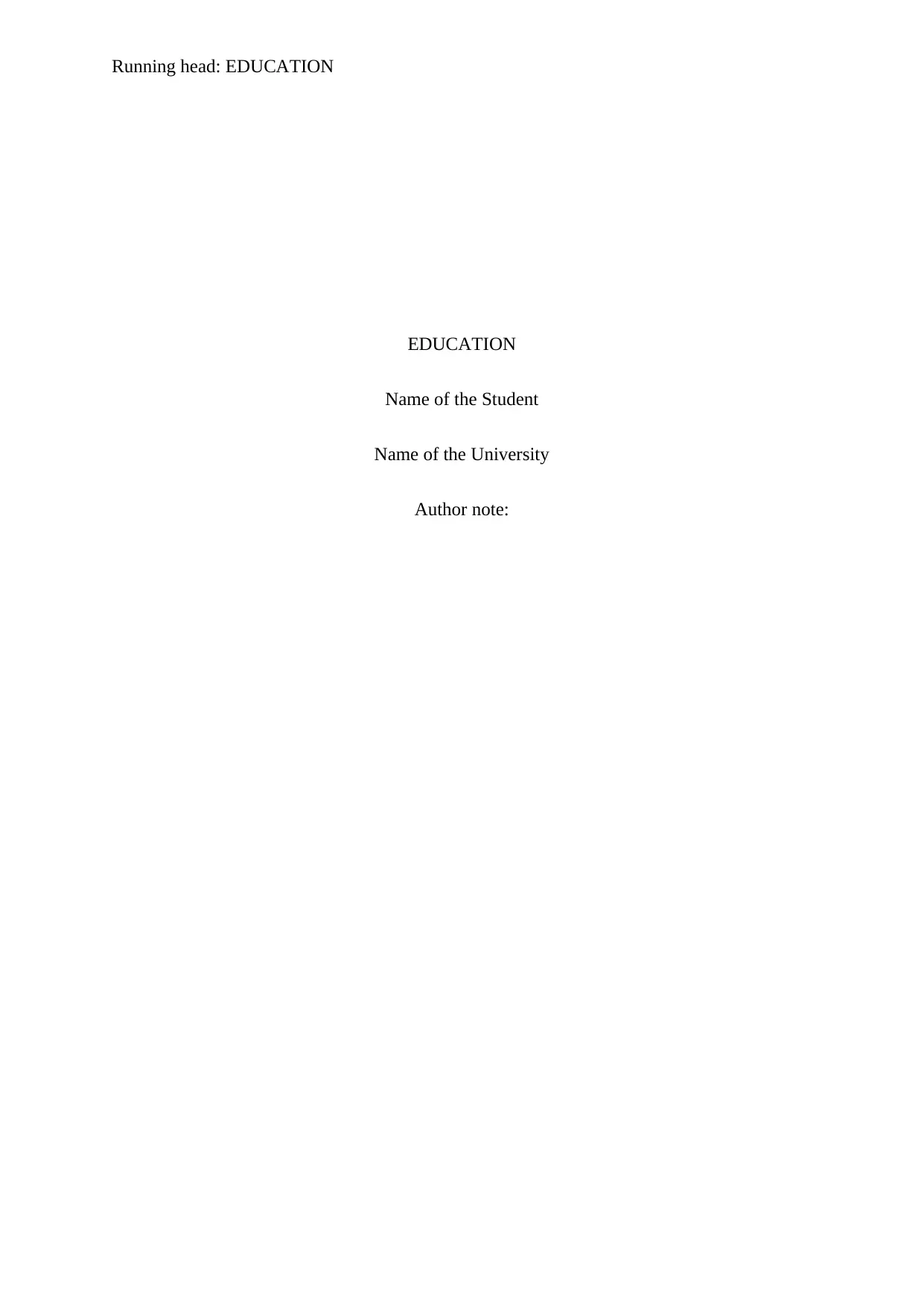
Running head: EDUCATION
EDUCATION
Name of the Student
Name of the University
Author note:
EDUCATION
Name of the Student
Name of the University
Author note:
Paraphrase This Document
Need a fresh take? Get an instant paraphrase of this document with our AI Paraphraser
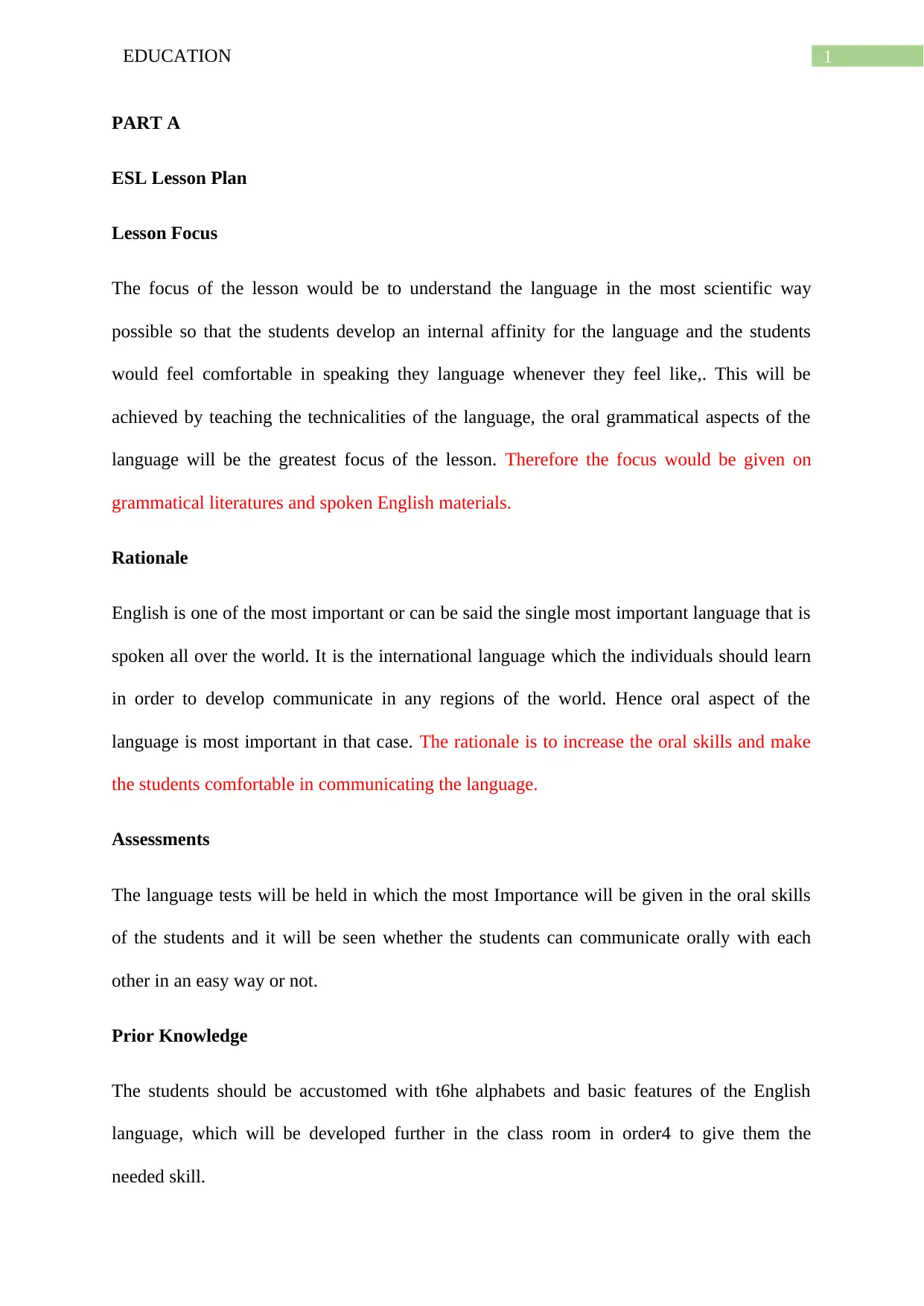
1EDUCATION
PART A
ESL Lesson Plan
Lesson Focus
The focus of the lesson would be to understand the language in the most scientific way
possible so that the students develop an internal affinity for the language and the students
would feel comfortable in speaking they language whenever they feel like,. This will be
achieved by teaching the technicalities of the language, the oral grammatical aspects of the
language will be the greatest focus of the lesson. Therefore the focus would be given on
grammatical literatures and spoken English materials.
Rationale
English is one of the most important or can be said the single most important language that is
spoken all over the world. It is the international language which the individuals should learn
in order to develop communicate in any regions of the world. Hence oral aspect of the
language is most important in that case. The rationale is to increase the oral skills and make
the students comfortable in communicating the language.
Assessments
The language tests will be held in which the most Importance will be given in the oral skills
of the students and it will be seen whether the students can communicate orally with each
other in an easy way or not.
Prior Knowledge
The students should be accustomed with t6he alphabets and basic features of the English
language, which will be developed further in the class room in order4 to give them the
needed skill.
PART A
ESL Lesson Plan
Lesson Focus
The focus of the lesson would be to understand the language in the most scientific way
possible so that the students develop an internal affinity for the language and the students
would feel comfortable in speaking they language whenever they feel like,. This will be
achieved by teaching the technicalities of the language, the oral grammatical aspects of the
language will be the greatest focus of the lesson. Therefore the focus would be given on
grammatical literatures and spoken English materials.
Rationale
English is one of the most important or can be said the single most important language that is
spoken all over the world. It is the international language which the individuals should learn
in order to develop communicate in any regions of the world. Hence oral aspect of the
language is most important in that case. The rationale is to increase the oral skills and make
the students comfortable in communicating the language.
Assessments
The language tests will be held in which the most Importance will be given in the oral skills
of the students and it will be seen whether the students can communicate orally with each
other in an easy way or not.
Prior Knowledge
The students should be accustomed with t6he alphabets and basic features of the English
language, which will be developed further in the class room in order4 to give them the
needed skill.
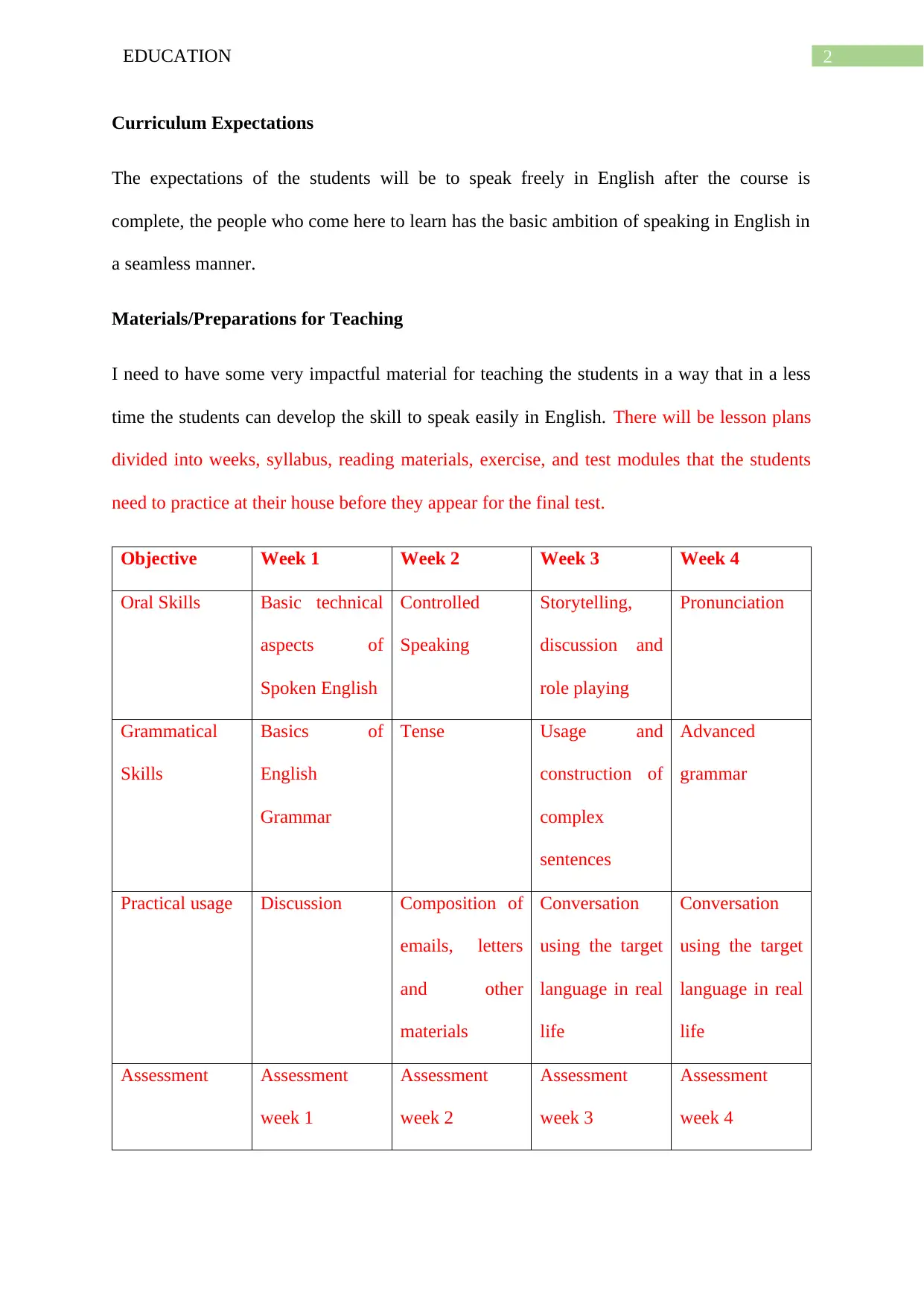
2EDUCATION
Curriculum Expectations
The expectations of the students will be to speak freely in English after the course is
complete, the people who come here to learn has the basic ambition of speaking in English in
a seamless manner.
Materials/Preparations for Teaching
I need to have some very impactful material for teaching the students in a way that in a less
time the students can develop the skill to speak easily in English. There will be lesson plans
divided into weeks, syllabus, reading materials, exercise, and test modules that the students
need to practice at their house before they appear for the final test.
Objective Week 1 Week 2 Week 3 Week 4
Oral Skills Basic technical
aspects of
Spoken English
Controlled
Speaking
Storytelling,
discussion and
role playing
Pronunciation
Grammatical
Skills
Basics of
English
Grammar
Tense Usage and
construction of
complex
sentences
Advanced
grammar
Practical usage Discussion Composition of
emails, letters
and other
materials
Conversation
using the target
language in real
life
Conversation
using the target
language in real
life
Assessment Assessment
week 1
Assessment
week 2
Assessment
week 3
Assessment
week 4
Curriculum Expectations
The expectations of the students will be to speak freely in English after the course is
complete, the people who come here to learn has the basic ambition of speaking in English in
a seamless manner.
Materials/Preparations for Teaching
I need to have some very impactful material for teaching the students in a way that in a less
time the students can develop the skill to speak easily in English. There will be lesson plans
divided into weeks, syllabus, reading materials, exercise, and test modules that the students
need to practice at their house before they appear for the final test.
Objective Week 1 Week 2 Week 3 Week 4
Oral Skills Basic technical
aspects of
Spoken English
Controlled
Speaking
Storytelling,
discussion and
role playing
Pronunciation
Grammatical
Skills
Basics of
English
Grammar
Tense Usage and
construction of
complex
sentences
Advanced
grammar
Practical usage Discussion Composition of
emails, letters
and other
materials
Conversation
using the target
language in real
life
Conversation
using the target
language in real
life
Assessment Assessment
week 1
Assessment
week 2
Assessment
week 3
Assessment
week 4
⊘ This is a preview!⊘
Do you want full access?
Subscribe today to unlock all pages.

Trusted by 1+ million students worldwide

3EDUCATION
Differentiated instruction
The batch will be kept small so that individual care can be taken for each of the student’s and
the students will be given dedicated time for their problems to be shared with the teacher. The
problems of the students will be recorded in an excel sheet which will be solved in due time.
Activities Roles for
teacher
Roles for
student
Materials
Presentation The study
materials and
syllabus to be
presented to the
students
To explain the
students all the
materials and
solve all the
problems
To understand,
learn and share
their problems
with the trainer.
Books and
printed material
Practice The given
materials to be
practiced by the
students so that
the fluency
increases. Class
assessments
The teacher has
to clear doubts
of the students
To practice at
home or at
spare time what
is given in the
class room, and
appear for mock
tests.
Mock test
Production Using the
language for
oral
communication
and the final
exams
To design the
assignments and
conduct test
Perform in the
test
Question papers
and answer
sheets.
Differentiated instruction
The batch will be kept small so that individual care can be taken for each of the student’s and
the students will be given dedicated time for their problems to be shared with the teacher. The
problems of the students will be recorded in an excel sheet which will be solved in due time.
Activities Roles for
teacher
Roles for
student
Materials
Presentation The study
materials and
syllabus to be
presented to the
students
To explain the
students all the
materials and
solve all the
problems
To understand,
learn and share
their problems
with the trainer.
Books and
printed material
Practice The given
materials to be
practiced by the
students so that
the fluency
increases. Class
assessments
The teacher has
to clear doubts
of the students
To practice at
home or at
spare time what
is given in the
class room, and
appear for mock
tests.
Mock test
Production Using the
language for
oral
communication
and the final
exams
To design the
assignments and
conduct test
Perform in the
test
Question papers
and answer
sheets.
Paraphrase This Document
Need a fresh take? Get an instant paraphrase of this document with our AI Paraphraser

4EDUCATION
Sharing Reflection
The success of the students will be measured in the final assessment and then it can be
understood the final lesson plan was proper for the teaching method or not.
Sharing Reflection
The success of the students will be measured in the final assessment and then it can be
understood the final lesson plan was proper for the teaching method or not.
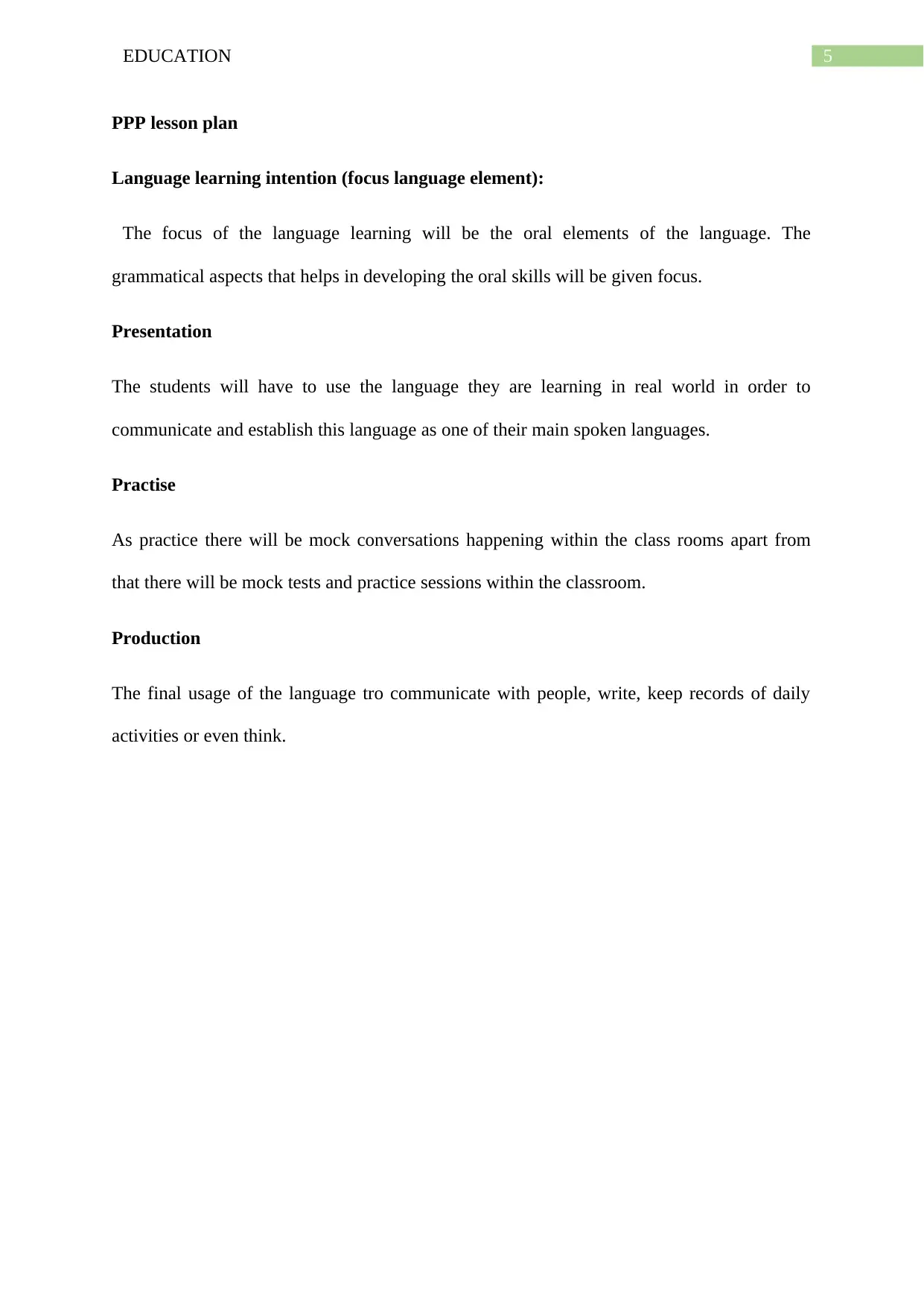
5EDUCATION
PPP lesson plan
Language learning intention (focus language element):
The focus of the language learning will be the oral elements of the language. The
grammatical aspects that helps in developing the oral skills will be given focus.
Presentation
The students will have to use the language they are learning in real world in order to
communicate and establish this language as one of their main spoken languages.
Practise
As practice there will be mock conversations happening within the class rooms apart from
that there will be mock tests and practice sessions within the classroom.
Production
The final usage of the language tro communicate with people, write, keep records of daily
activities or even think.
PPP lesson plan
Language learning intention (focus language element):
The focus of the language learning will be the oral elements of the language. The
grammatical aspects that helps in developing the oral skills will be given focus.
Presentation
The students will have to use the language they are learning in real world in order to
communicate and establish this language as one of their main spoken languages.
Practise
As practice there will be mock conversations happening within the class rooms apart from
that there will be mock tests and practice sessions within the classroom.
Production
The final usage of the language tro communicate with people, write, keep records of daily
activities or even think.
⊘ This is a preview!⊘
Do you want full access?
Subscribe today to unlock all pages.

Trusted by 1+ million students worldwide
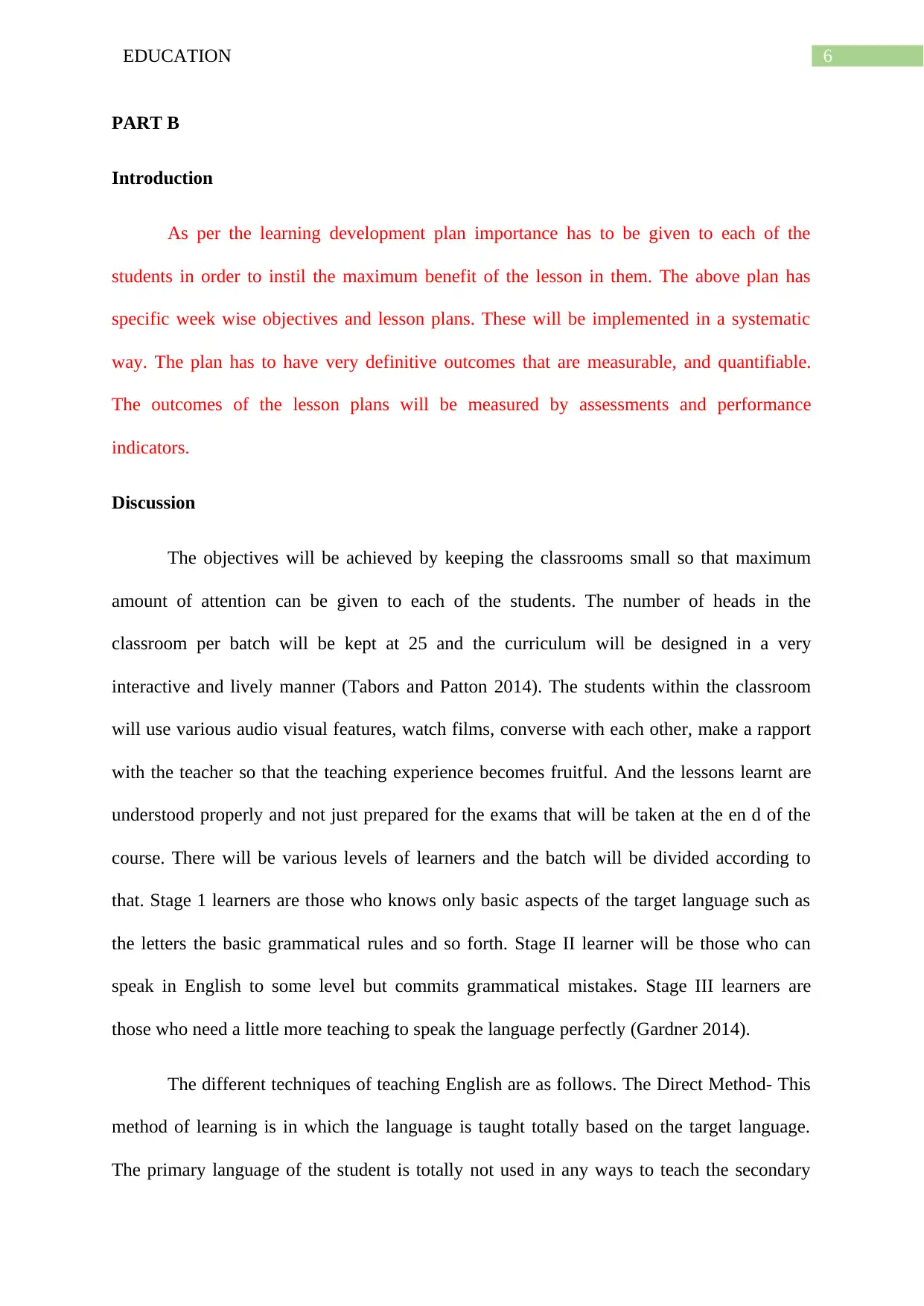
6EDUCATION
PART B
Introduction
As per the learning development plan importance has to be given to each of the
students in order to instil the maximum benefit of the lesson in them. The above plan has
specific week wise objectives and lesson plans. These will be implemented in a systematic
way. The plan has to have very definitive outcomes that are measurable, and quantifiable.
The outcomes of the lesson plans will be measured by assessments and performance
indicators.
Discussion
The objectives will be achieved by keeping the classrooms small so that maximum
amount of attention can be given to each of the students. The number of heads in the
classroom per batch will be kept at 25 and the curriculum will be designed in a very
interactive and lively manner (Tabors and Patton 2014). The students within the classroom
will use various audio visual features, watch films, converse with each other, make a rapport
with the teacher so that the teaching experience becomes fruitful. And the lessons learnt are
understood properly and not just prepared for the exams that will be taken at the en d of the
course. There will be various levels of learners and the batch will be divided according to
that. Stage 1 learners are those who knows only basic aspects of the target language such as
the letters the basic grammatical rules and so forth. Stage II learner will be those who can
speak in English to some level but commits grammatical mistakes. Stage III learners are
those who need a little more teaching to speak the language perfectly (Gardner 2014).
The different techniques of teaching English are as follows. The Direct Method- This
method of learning is in which the language is taught totally based on the target language.
The primary language of the student is totally not used in any ways to teach the secondary
PART B
Introduction
As per the learning development plan importance has to be given to each of the
students in order to instil the maximum benefit of the lesson in them. The above plan has
specific week wise objectives and lesson plans. These will be implemented in a systematic
way. The plan has to have very definitive outcomes that are measurable, and quantifiable.
The outcomes of the lesson plans will be measured by assessments and performance
indicators.
Discussion
The objectives will be achieved by keeping the classrooms small so that maximum
amount of attention can be given to each of the students. The number of heads in the
classroom per batch will be kept at 25 and the curriculum will be designed in a very
interactive and lively manner (Tabors and Patton 2014). The students within the classroom
will use various audio visual features, watch films, converse with each other, make a rapport
with the teacher so that the teaching experience becomes fruitful. And the lessons learnt are
understood properly and not just prepared for the exams that will be taken at the en d of the
course. There will be various levels of learners and the batch will be divided according to
that. Stage 1 learners are those who knows only basic aspects of the target language such as
the letters the basic grammatical rules and so forth. Stage II learner will be those who can
speak in English to some level but commits grammatical mistakes. Stage III learners are
those who need a little more teaching to speak the language perfectly (Gardner 2014).
The different techniques of teaching English are as follows. The Direct Method- This
method of learning is in which the language is taught totally based on the target language.
The primary language of the student is totally not used in any ways to teach the secondary
Paraphrase This Document
Need a fresh take? Get an instant paraphrase of this document with our AI Paraphraser
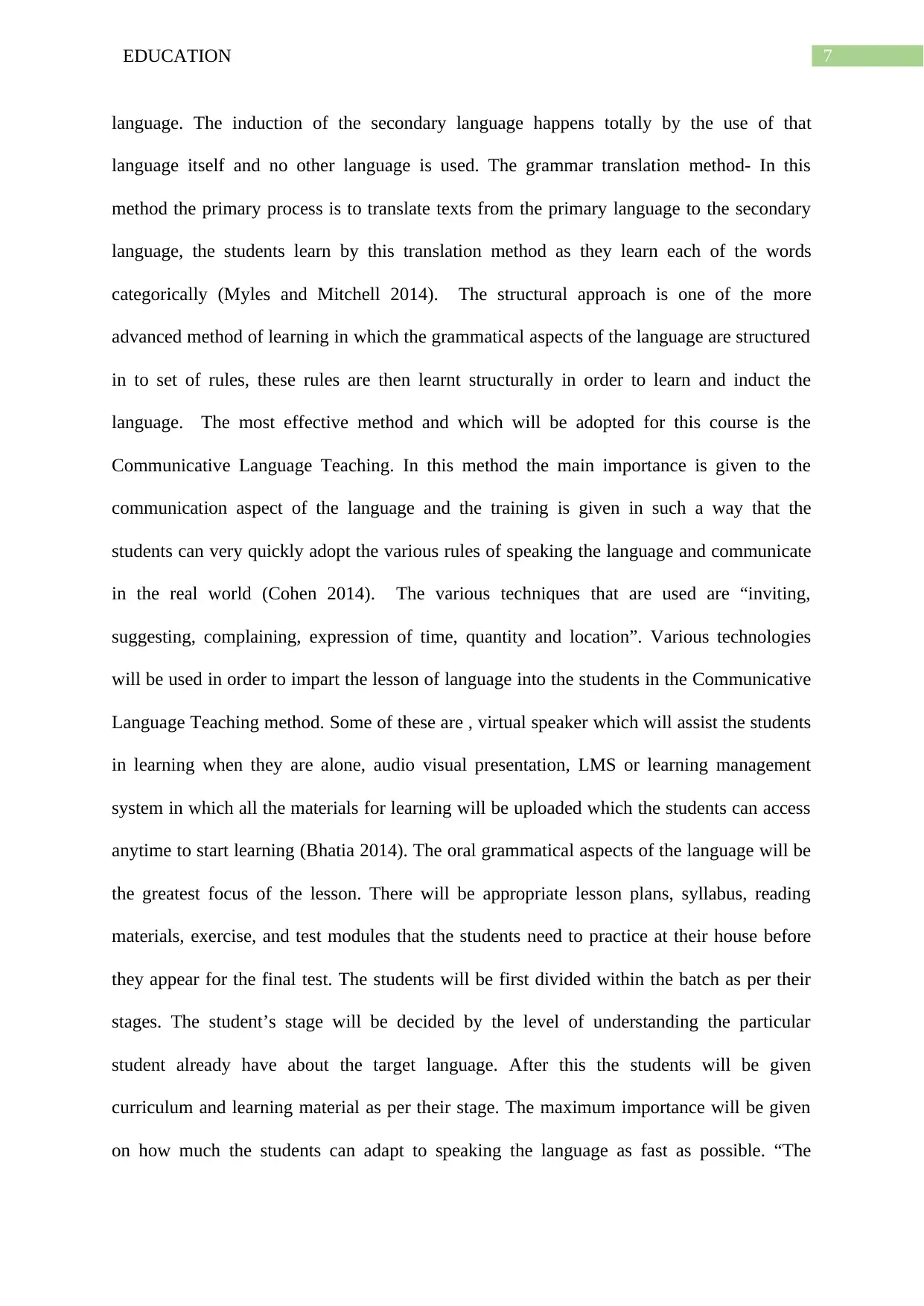
7EDUCATION
language. The induction of the secondary language happens totally by the use of that
language itself and no other language is used. The grammar translation method- In this
method the primary process is to translate texts from the primary language to the secondary
language, the students learn by this translation method as they learn each of the words
categorically (Myles and Mitchell 2014). The structural approach is one of the more
advanced method of learning in which the grammatical aspects of the language are structured
in to set of rules, these rules are then learnt structurally in order to learn and induct the
language. The most effective method and which will be adopted for this course is the
Communicative Language Teaching. In this method the main importance is given to the
communication aspect of the language and the training is given in such a way that the
students can very quickly adopt the various rules of speaking the language and communicate
in the real world (Cohen 2014). The various techniques that are used are “inviting,
suggesting, complaining, expression of time, quantity and location”. Various technologies
will be used in order to impart the lesson of language into the students in the Communicative
Language Teaching method. Some of these are , virtual speaker which will assist the students
in learning when they are alone, audio visual presentation, LMS or learning management
system in which all the materials for learning will be uploaded which the students can access
anytime to start learning (Bhatia 2014). The oral grammatical aspects of the language will be
the greatest focus of the lesson. There will be appropriate lesson plans, syllabus, reading
materials, exercise, and test modules that the students need to practice at their house before
they appear for the final test. The students will be first divided within the batch as per their
stages. The student’s stage will be decided by the level of understanding the particular
student already have about the target language. After this the students will be given
curriculum and learning material as per their stage. The maximum importance will be given
on how much the students can adapt to speaking the language as fast as possible. “The
language. The induction of the secondary language happens totally by the use of that
language itself and no other language is used. The grammar translation method- In this
method the primary process is to translate texts from the primary language to the secondary
language, the students learn by this translation method as they learn each of the words
categorically (Myles and Mitchell 2014). The structural approach is one of the more
advanced method of learning in which the grammatical aspects of the language are structured
in to set of rules, these rules are then learnt structurally in order to learn and induct the
language. The most effective method and which will be adopted for this course is the
Communicative Language Teaching. In this method the main importance is given to the
communication aspect of the language and the training is given in such a way that the
students can very quickly adopt the various rules of speaking the language and communicate
in the real world (Cohen 2014). The various techniques that are used are “inviting,
suggesting, complaining, expression of time, quantity and location”. Various technologies
will be used in order to impart the lesson of language into the students in the Communicative
Language Teaching method. Some of these are , virtual speaker which will assist the students
in learning when they are alone, audio visual presentation, LMS or learning management
system in which all the materials for learning will be uploaded which the students can access
anytime to start learning (Bhatia 2014). The oral grammatical aspects of the language will be
the greatest focus of the lesson. There will be appropriate lesson plans, syllabus, reading
materials, exercise, and test modules that the students need to practice at their house before
they appear for the final test. The students will be first divided within the batch as per their
stages. The student’s stage will be decided by the level of understanding the particular
student already have about the target language. After this the students will be given
curriculum and learning material as per their stage. The maximum importance will be given
on how much the students can adapt to speaking the language as fast as possible. “The

8EDUCATION
flipped classroom method of teaching” will also be adopted. In this the students will be given
the lesson to be taught in the classroom from one day prior (Carter and McRae 2014). The
student will study and understand whatever they can and then come to the classrooms with
their doubts, which will be then cleared by the teacher within the classroom. Therefore the
ultimate overall situation of the classroom will be, the classrooms will be small, lesser
students, and the technique will be Communicative Language Teaching, the method will be
“Flipped classroom teaching”, and various technologies will be online tools, Learning
management system, and audio visual presentations.
The strategies which are selected for imparting teaching of English language to the
students are having some short comings. These short comings needs to be contemplated upon
before finally the method is applied in the classrooms. The various methods of teaching
language have their own flaws. Communicative Language Teaching is sometimes criticised
as the over simplification of the method (Larsen-Freeman and Long 2014). It is very
important for a person who is trying to learn a new language to understand the grammatical
aspects of the language. Without learning grammar and the technical aspects the students will
find it difficult in writing the language. Therefore the structural approach is important in this
case. Again a person is most comfortable in their own primary language which is also known
as the mother tongue (Saville-Troike and Barto 2016). This mother tongue is the language in
which a person develops the process of thinking therefore it is important to use the mother
tongue or the primary language to impart teaching of the target language. The process of
grammar translation method is hence considered very important and still practiced in many
parts of the world. Especially in the schools of the developing countries this process is widely
practiced. On the other hand the process of Communicative language teaching is criticised as
being a process which is more dedicate towards the spoken aspect of a language and less
towards written aspect. The idea that a short class room helps in the learning process is
flipped classroom method of teaching” will also be adopted. In this the students will be given
the lesson to be taught in the classroom from one day prior (Carter and McRae 2014). The
student will study and understand whatever they can and then come to the classrooms with
their doubts, which will be then cleared by the teacher within the classroom. Therefore the
ultimate overall situation of the classroom will be, the classrooms will be small, lesser
students, and the technique will be Communicative Language Teaching, the method will be
“Flipped classroom teaching”, and various technologies will be online tools, Learning
management system, and audio visual presentations.
The strategies which are selected for imparting teaching of English language to the
students are having some short comings. These short comings needs to be contemplated upon
before finally the method is applied in the classrooms. The various methods of teaching
language have their own flaws. Communicative Language Teaching is sometimes criticised
as the over simplification of the method (Larsen-Freeman and Long 2014). It is very
important for a person who is trying to learn a new language to understand the grammatical
aspects of the language. Without learning grammar and the technical aspects the students will
find it difficult in writing the language. Therefore the structural approach is important in this
case. Again a person is most comfortable in their own primary language which is also known
as the mother tongue (Saville-Troike and Barto 2016). This mother tongue is the language in
which a person develops the process of thinking therefore it is important to use the mother
tongue or the primary language to impart teaching of the target language. The process of
grammar translation method is hence considered very important and still practiced in many
parts of the world. Especially in the schools of the developing countries this process is widely
practiced. On the other hand the process of Communicative language teaching is criticised as
being a process which is more dedicate towards the spoken aspect of a language and less
towards written aspect. The idea that a short class room helps in the learning process is
⊘ This is a preview!⊘
Do you want full access?
Subscribe today to unlock all pages.

Trusted by 1+ million students worldwide
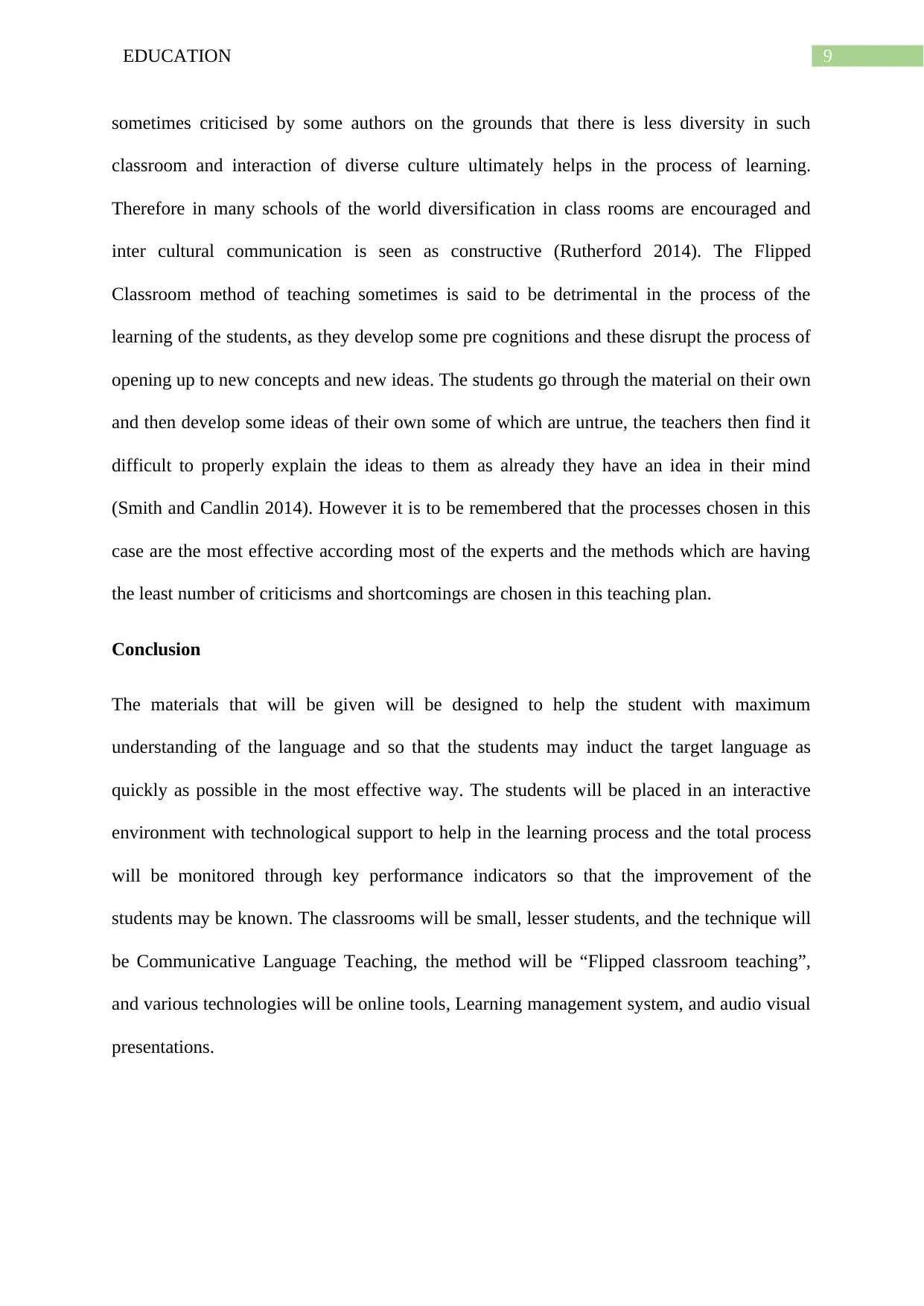
9EDUCATION
sometimes criticised by some authors on the grounds that there is less diversity in such
classroom and interaction of diverse culture ultimately helps in the process of learning.
Therefore in many schools of the world diversification in class rooms are encouraged and
inter cultural communication is seen as constructive (Rutherford 2014). The Flipped
Classroom method of teaching sometimes is said to be detrimental in the process of the
learning of the students, as they develop some pre cognitions and these disrupt the process of
opening up to new concepts and new ideas. The students go through the material on their own
and then develop some ideas of their own some of which are untrue, the teachers then find it
difficult to properly explain the ideas to them as already they have an idea in their mind
(Smith and Candlin 2014). However it is to be remembered that the processes chosen in this
case are the most effective according most of the experts and the methods which are having
the least number of criticisms and shortcomings are chosen in this teaching plan.
Conclusion
The materials that will be given will be designed to help the student with maximum
understanding of the language and so that the students may induct the target language as
quickly as possible in the most effective way. The students will be placed in an interactive
environment with technological support to help in the learning process and the total process
will be monitored through key performance indicators so that the improvement of the
students may be known. The classrooms will be small, lesser students, and the technique will
be Communicative Language Teaching, the method will be “Flipped classroom teaching”,
and various technologies will be online tools, Learning management system, and audio visual
presentations.
sometimes criticised by some authors on the grounds that there is less diversity in such
classroom and interaction of diverse culture ultimately helps in the process of learning.
Therefore in many schools of the world diversification in class rooms are encouraged and
inter cultural communication is seen as constructive (Rutherford 2014). The Flipped
Classroom method of teaching sometimes is said to be detrimental in the process of the
learning of the students, as they develop some pre cognitions and these disrupt the process of
opening up to new concepts and new ideas. The students go through the material on their own
and then develop some ideas of their own some of which are untrue, the teachers then find it
difficult to properly explain the ideas to them as already they have an idea in their mind
(Smith and Candlin 2014). However it is to be remembered that the processes chosen in this
case are the most effective according most of the experts and the methods which are having
the least number of criticisms and shortcomings are chosen in this teaching plan.
Conclusion
The materials that will be given will be designed to help the student with maximum
understanding of the language and so that the students may induct the target language as
quickly as possible in the most effective way. The students will be placed in an interactive
environment with technological support to help in the learning process and the total process
will be monitored through key performance indicators so that the improvement of the
students may be known. The classrooms will be small, lesser students, and the technique will
be Communicative Language Teaching, the method will be “Flipped classroom teaching”,
and various technologies will be online tools, Learning management system, and audio visual
presentations.
Paraphrase This Document
Need a fresh take? Get an instant paraphrase of this document with our AI Paraphraser
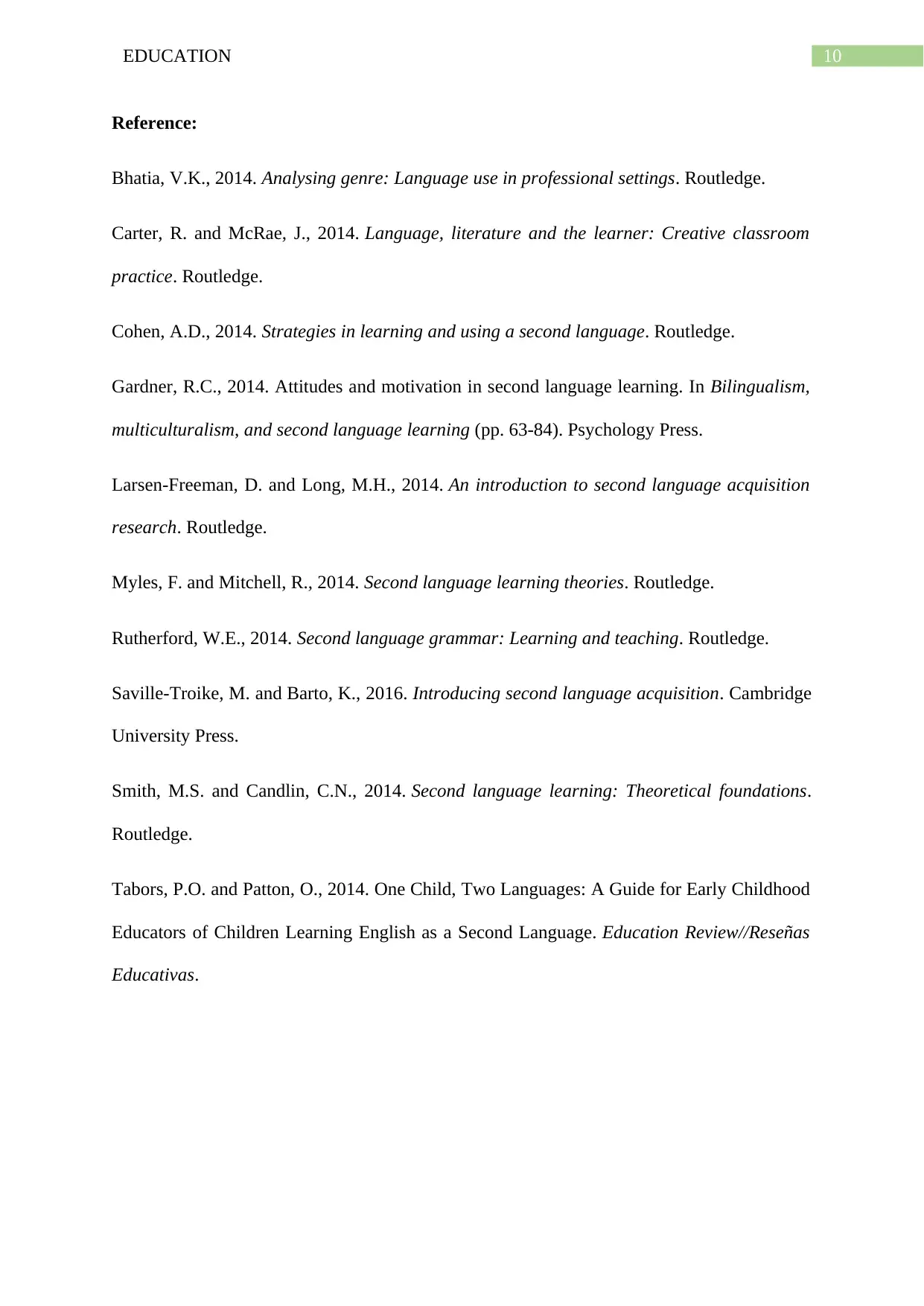
10EDUCATION
Reference:
Bhatia, V.K., 2014. Analysing genre: Language use in professional settings. Routledge.
Carter, R. and McRae, J., 2014. Language, literature and the learner: Creative classroom
practice. Routledge.
Cohen, A.D., 2014. Strategies in learning and using a second language. Routledge.
Gardner, R.C., 2014. Attitudes and motivation in second language learning. In Bilingualism,
multiculturalism, and second language learning (pp. 63-84). Psychology Press.
Larsen-Freeman, D. and Long, M.H., 2014. An introduction to second language acquisition
research. Routledge.
Myles, F. and Mitchell, R., 2014. Second language learning theories. Routledge.
Rutherford, W.E., 2014. Second language grammar: Learning and teaching. Routledge.
Saville-Troike, M. and Barto, K., 2016. Introducing second language acquisition. Cambridge
University Press.
Smith, M.S. and Candlin, C.N., 2014. Second language learning: Theoretical foundations.
Routledge.
Tabors, P.O. and Patton, O., 2014. One Child, Two Languages: A Guide for Early Childhood
Educators of Children Learning English as a Second Language. Education Review//Reseñas
Educativas.
Reference:
Bhatia, V.K., 2014. Analysing genre: Language use in professional settings. Routledge.
Carter, R. and McRae, J., 2014. Language, literature and the learner: Creative classroom
practice. Routledge.
Cohen, A.D., 2014. Strategies in learning and using a second language. Routledge.
Gardner, R.C., 2014. Attitudes and motivation in second language learning. In Bilingualism,
multiculturalism, and second language learning (pp. 63-84). Psychology Press.
Larsen-Freeman, D. and Long, M.H., 2014. An introduction to second language acquisition
research. Routledge.
Myles, F. and Mitchell, R., 2014. Second language learning theories. Routledge.
Rutherford, W.E., 2014. Second language grammar: Learning and teaching. Routledge.
Saville-Troike, M. and Barto, K., 2016. Introducing second language acquisition. Cambridge
University Press.
Smith, M.S. and Candlin, C.N., 2014. Second language learning: Theoretical foundations.
Routledge.
Tabors, P.O. and Patton, O., 2014. One Child, Two Languages: A Guide for Early Childhood
Educators of Children Learning English as a Second Language. Education Review//Reseñas
Educativas.
1 out of 11
Related Documents
Your All-in-One AI-Powered Toolkit for Academic Success.
+13062052269
info@desklib.com
Available 24*7 on WhatsApp / Email
![[object Object]](/_next/static/media/star-bottom.7253800d.svg)
Unlock your academic potential
Copyright © 2020–2025 A2Z Services. All Rights Reserved. Developed and managed by ZUCOL.





